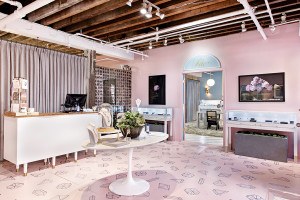3D-Printed Jewelry Brand, ZveSao, Takes Off

Photo by Luke Vink Provided
The future of fashion is here and it comes in a starry and chained design meant to be draped or hung on the body. Adding to Boston’s budding assembly of smart fashion brands is ZveSao, a 3D-printed jewelry line started by local entrepreneur Paulina Perepelkin.
The line’s premiere collection, which was designed in collaboration with MassArt graduate Yen Nguyen, debuted last month at Storyville nightclub and became available for sale online the following morning.
At the fashion show, models presented the line’s six runway pieces that are priced from $1,500 to $3,950. Six additional ready-to-wear baubles were revealed on the ZveSao website, which cost $150 and up.
“They are larger pieces [that] fit on the body a different way,” says Perepelkin of the runway pieces. “So we really want to fit them to each individual when we do sell them.”
The brand’s runway and ready-to-wear jewelry were manufactured by EOS and ShapeWays 3D printers, respectively. Through a selective laser sintering process, the pieces were created using powdered nylon.
“ZveSao” is a combination of the word “star” in both Russian and Vietnamese. The line also combines two different industries.
“I feel like I have always been aware of the two worlds: fashion and technology,” says Perepelkin. “The two have been closely linked for eons. … Loom punchcards were the basis for the first computer.”
3D printing, or additive manufacturing, is a topic Perepelkin has been closely studying since 2012, when she was writing her master’s thesis on the potential impact of 3D printing on the fashion industry.
To compile her research, she started her own website, Additive Fashion, where she writes about the 3D-printing industry. Through blogging, she discovered and networked with local initiatives and individuals who were exploring the same field.
“There’s a lot of interest in the area and it’s very understandable,” says Perepelkin. “Boston is a hotbed for artistic expression.”
Perepelkin believes the close proximity of art schools such as MassArt and technical schools like MIT has influenced the merging of fashion and technology in the city.
As an example, Perepelkin points to the “Descience: Research on the Runway” competition held last September at MIT Media Lab. This event brought together 44 scientists and clothing designers from around the world to create garments inspired by scientific fields of study.
Upcoming similar events include the Fab Foundation’s 11th annual conference on digital fabrication in August and a panel discussion on fashion and tech at the MFA in partnership with Descience and Cambridge Enterprise Forum in September.
During a local event on 3D printing, Perepelkin and Nguyen met and began bouncing ideas off each other for a 3D-printed line two years ago.
“We’re just two women intent on making a wave in this field,” said Nguyen, who helped design a wearable 3D-printed dress as part of Descience’s competition last year.
Boston’s role in the fashion world, Perepelkin says, which has been hidden behind New York’s reigning one, can be an advantage.
“New York has traditionally been a fashion capital which comes with limitations in terms of traditional fashion infrastructure,” says Perepelkin. “We don’t exactly have that, so we have more freedom to experiment and innovate.”
For Perepelkin, additive manufacturing is a possible solution to many of the fashion industry’s social problems such as labor practices, and environmental issues like the use of pesticides in cotton plants and toxic dyes in fabrics.
“Additive manufacturing brings manufacturing of the item closer to the designer,” she says. “You know exactly how the item is being produced.”
3D printing today is not meant for mass production, but “that’s the beauty of it,” says Perepelkin. “It works for customization and bespoke design.”
“It’s easier to tweak a design because you can just adjust it on the software before printing it,” says Nguyen. “If you’re making something by hand, it’s harder to make changes.”
Perepelkin’s vision for ZveSao is to extend the line from jewelry to other fashion consumer items, such as garments.
“Additive manufacturing used to be something only big companies were able to do,” said Nguyen. “But now we’re doing it, and consumers can wear it.”


